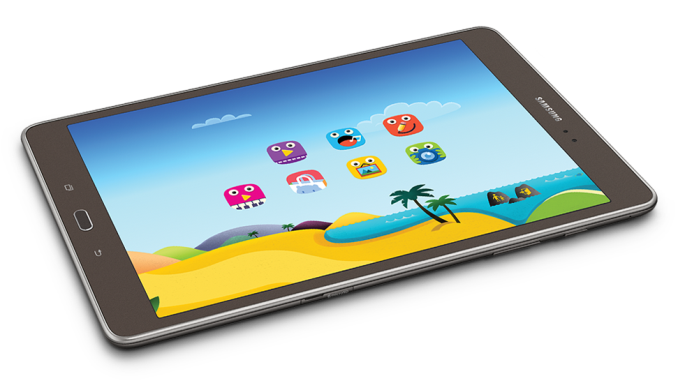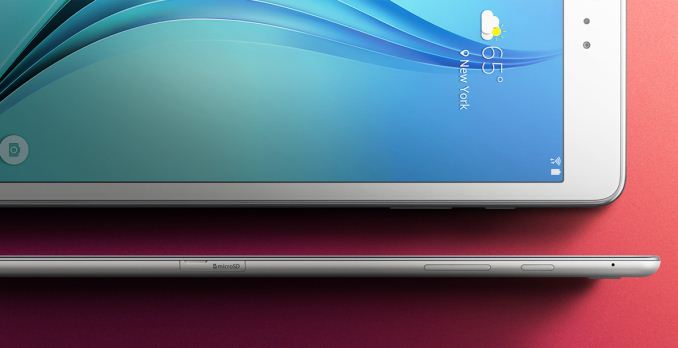Samsung Introduces New 8" and 9.7" Galaxy Tab A Tablets
by Brandon Chester on April 20, 2015 3:28 PM EST
Today Samsung Electronics America announced two new tablets that are coming to market in the United States. Samsung's new Galaxy Tab A tablets come in 8.0" and 9.7" sizes, and Samsung is marketing them as tablets that are well suited for keeping in touch with friends and family. The specs of both tablets are laid out in the chart below.
| Samsung Galaxy Tab A 8.0" | Samsung Galaxy Tab A 9.7" | |
| SoC | Snapdragon 410 (APQ8016) 4x 1.2GHz Cortex A53, 400MHz Adreno 306 GPU |
|
| RAM/NAND | 16/32GB NAND + MicroSDXC, 1.5GB RAM | |
| Display | 8.0" 1024x768 PLS LCD | 9.7" 1024x768 PLS LCD |
| Dimensions | 208.4 x 137.9 x 7.5mm, 313g | 242.5 x 166.8 x 7.5mm, 449g |
| Camera | 5MP Rear Facing, 2MP Front Facing | |
| Battery | 4200 mAh (15.96 Whr) | 6000 mAh (22.8 Whr) |
| OS | Android 5.0 Lollipop | |
| Connectivity | 802.11 a/b/g/n + BT 4.0, microUSB2.0 | |
Both tablets have very similar specifications. They are both distinctly mid-range tablets, with Qualcomm's Snapdragon 410 at their heart, 1.5GB of RAM, and a 1024x768 PLS display. They're really only differentiated by the size of their displays, and subsequently their dimensions and battery capacity. I think it may be difficult for Samsung to charge a price premium for the 9.7" model when it doesn't have any improvements to display resolution or internal hardware over the 8.0" model.
What makes these new tablets stand out from Samsung's previous tablet offerings are their sizes and their design. Both tablets have a 4:3 aspect ratio, which is a significant departure from the 16:10 tablets that Samsung has produced in the past. Both tablets also have a full metal chassis, which will be an enormous improvement over the plastic construction of Samsung's other tablets. I am very interested to see what Samsung can do with this type of design on a high end tablet with flagship specifications.
Update: This article previously stated that he Galaxy Tab A tablets have a metal chassis. According to Samsung this is not actually the case.
Both Galaxy Tab A models are available for preorder now, and they'll begin to ship on May 1st in the United States. Both models are available in white, titanium, and blue finishes. The 8.0" model costs at $229, while the 9.7" model costs $299. There will also be a version of the 9.7" model with Samsung's S-pen included for $349. Through Samsung's new app partnership with Microsoft, the new tablets will come with Microsoft's Office for Android applications preinstalled, and buyers will receive 100GB of OneDrive storage for two years.
Source: Samsung via Businesswire











62 Comments
View All Comments
ddriver - Wednesday, April 22, 2015 - link
XGA was introduced in 1990, SVGA (800x600) in 1987, 1024x768 in the 80's on 286 - don't make me laugh. I actually had computers during the 80s, first half 320x200 resolution was considered HIGH END. The mainstream was barely reaching 640x480 in the end.Besides, no one is forcing you to buy, so quit whining.
pSupaNova - Sunday, April 26, 2015 - link
Also with a lower resolution this tab should fly at 3D games. Putting to high a resolution on tabs kills graphical performance and drains the battery.Pratts - Sunday, April 26, 2020 - link
I understand it's an old article, however I believe this might be still relevant.When I run the numbers through an online PPI calculator tool like https://pixelsperinchcalc.com/ the result is quite awful. I don't think we get the value for money for this product by any stretch of imagination!!
StevoLincolnite - Wednesday, April 29, 2015 - link
I had a 10" CRT with a 1024x768 resolution 20 years ago.Even 1280x720/1366x768 would have been a good improvement...
TallestJon96 - Tuesday, April 21, 2015 - link
It funny how now 'just HD' is an eyesoreclose - Tuesday, April 21, 2015 - link
It is when you're viewing it from 30cm away. Also, it's funny how a 32Kbps internet connection is painfully slow these days :).Jon Tseng - Tuesday, April 21, 2015 - link
32Kbps? Man I remember when by 9600 baud USR Courier was the king!Anyhow you can game on a MUD perfectly well at 2400 baud. What more do you need?
kaidenshi - Tuesday, April 21, 2015 - link
Try D&D played via Morse Code on the 40 meter ham band across the Atlantic ocean. Nothing like rolling for initiative at 12 words per minute!Samus - Tuesday, April 21, 2015 - link
Personally I think 1920x1200 or more commonly 1080P is acceptable on just about any screen between 7"-12" (tablet) 13"-24" (monitor) and 32"-55" (television)I know people will disagree with me, but this resolution works for me in those devices at those sizes based on how far back I sit from them and the age of my eyes.
2560x1440 is killer in 27-32" devices, though, because a 1080P device drops well below 90PPI at these sizes; you can notice edges of a circle at a 2 foot viewing distance (that's always my test...how round a circle is)
Ideally you want the PPI to be:
200PPI+ when working with a device 6" away from eyes
160+ when working with a device 12" away
120+ when working with a device 18" away
90+ when working with a device 24" away.
No less than 36PPI @ 10 feet.
The last statement is important because it's the 50PPI cutoff that keeps bringing us to higher TV resolutions. I don't know if anyone has ever seen, say, a 720P (1366x768 max) 42" TV. They were quite common in the mid 2000's. They had around 36PPI, which amusingly made the pixels nearly as large as an infants fingernail. You wouldn't really notice how bad it was if sitting on a couch 10 feet away, but this ushered in the need for 1080P TV's, and now 2160P or QHD, because even 1080P on a 55" TV (this is the most common size set sold according to Consumer Reports) is 45PPI. Again, you won't notice when up close, but if companies like Sharp and Samsung want to sell 65"-90" sets in the mainstream, 1080P just looks embarrassing, especially when people are viewing them in a showroom or aisle in Costco at a close distance.
I've heard in AV circles that for TV displays you want the PPI to be equal to each inch when viewing from 10 feet. This saying has some exceptions which is why i don't like it, but it's a good base point. The main reason I don't like it is because it really only applies to large TV's since anything less than ~46" would have less than 46PPI.
Example matches at 10 feet viewing distance:
32" 720P 49PPI
40" 720P 39PPI (matched inch to PPI ratio)
46" 720P 34PPI
46" 1080P 48PPI (matched inch to PPI ratio)
65" 1080P 34PPI
80" 1080P 28PPI
46" QHD 96PPI
65" QHD 68PPI (matched inch to PPI ratio)
UtilityMax - Friday, April 24, 2015 - link
I disagree with you. I think 1080p is not acceptable on a desktop monitor bigger than 20 inches. That's because you sit close to it, so your eyes can see a lot of detail. I can clearly see pixels when reading text on a 24 inch 1080p monitor. On the other hand, 1080p is fine for televisions because you typically sit 6-9ft away from the screen. Likewise on tablets.